26th August, 2025
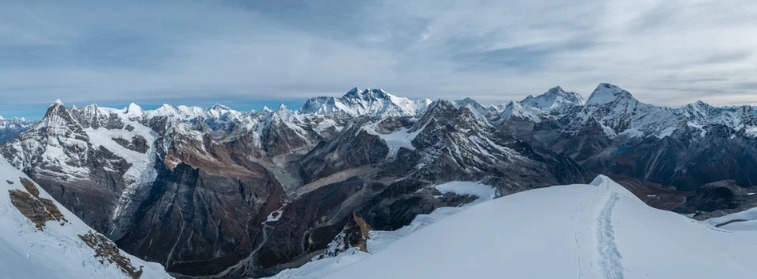
Feb 13, 2024
Mera Peak Climbing in November
- What Are The Merits Of Mera Peak Climbing In November?
- What is the Weather and Climate Like When Climbing Mera Peak in November?
- Highlights of Mera Peak Climbing In November
- Difficulties of Mera Peak Climbing in November
- Is Mera Peak Climbing In November Feasible For Me?
- Preparations For The Mera Peak Climb
- Do I Need Any Mountaineering Skills For Mera Peak Climbing In November?
- What About Accommodations And Meals While Mera Peak Climbing In November?
- Useful Tips For Mera Peak Climbing In November
- Can I See Mount Everest From Mera Peak?
- Which Mountain Should I Climb After Mera Peak?
- Can I Hire Climbing Gear From Khare?
- Conclusion
- Mera Peak Climbing Packages
Climbing Mera Peak in November offers a unique and rewarding experience amidst Nepal's Himalayas. November is the tail end of the post-monsoon season, characterized by clear skies, stable weather conditions, and crisp mountain air, making it an ideal time for trekking and climbing in the Everest region.
The journey typically begins with a scenic flight from Kathmandu to Lukla, followed by a trek through picturesque Sherpa villages such as Namche Bazaar and Pangboche. These villages offer insights into the local culture and provide opportunities to acclimatize gradually before heading towards Mera Peak.
Weather in November is generally dry, with daytime temperatures ranging from mild to cool, making trekking comfortable during the day. Nights can be cold, especially at higher elevations, so climbers need to be prepared with adequate cold-weather gear including warm clothing, sleeping bags rated for sub-zero temperatures, and insulated sleeping mats.
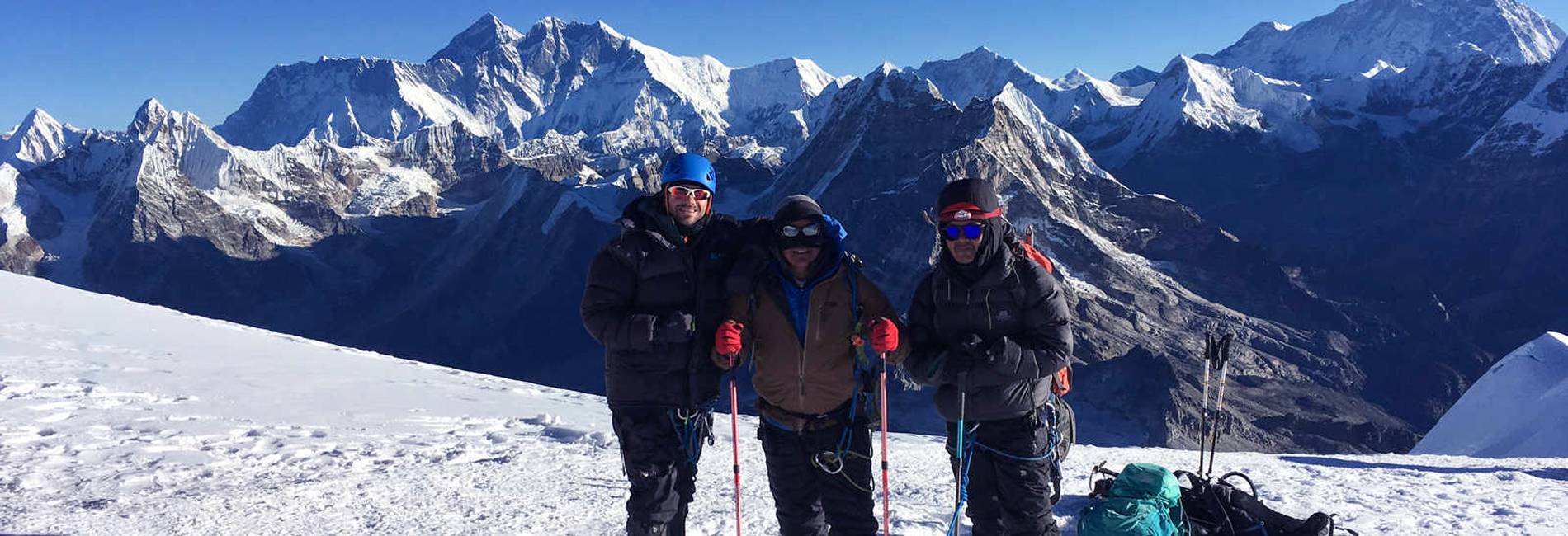
MERA PEAK CLIMBING
Mera Peak Climbing is an exhilarating adventure in Nepal that gives you an opportunity to reach the summit of Mera Peak at more than 6400m above sea level. Actually, it is the highest climbing (w...
The ascent to Mera Peak involves traversing diverse terrain including rhododendron forests, moraines, and glacier crossings. The final push to the summit requires ascending a snow slope, where climbers may use crampons and ice axes. While technically non-technical, Mera Peak climbing demands a good level of physical fitness and stamina due to the high altitude.
November offers clear visibility of the surrounding Himalayan peaks, including Everest, Lhotse, and Makalu, providing breathtaking panoramic views from various points along the trek. The quieter trails compared to peak seasons ensure a more serene trekking experience with fewer crowds, enhancing the sense of wilderness and adventure.
Overall, climbing Mera Peak in November combines adventure with stunning natural beauty, cultural immersion, and a sense of accomplishment upon reaching the summit. It's an excellent choice for mountaineers and trekkers seeking an off-the-beaten-path Himalayan experience during the post-monsoon season.

MERA PEAK CLIMBING 17 DAYS
This is an excellent opportunity to climb Nepal’s highest peak without having to obtain a permit (6,476m/21,190ft). From the summit, you will have stunning views of several 8000m plus peaks, such as E...
What Are The Merits Of Mera Peak Climbing In November?
Climbing Mera Peak in November offers several merits that make it a favored choice among mountaineers and trekkers:
- Stable Weather: November falls after the monsoon season, offering stable weather with clear skies and reduced chances of precipitation. This enhances visibility and provides optimal conditions for trekking and climbing.
- Comfortable Temperatures: Daytime temperatures are moderate, making trekking pleasant. Cooler nights at higher elevations are manageable with proper cold-weather gear.
- Clear Views: The post-monsoon period brings clear views of the Himalayan peaks, including Everest, Lhotse, and Makalu, from various vantage points along the trek. This enhances the overall experience and rewards climbers with breathtaking vistas.
- Fewer Crowds: Compared to peak trekking seasons, November sees fewer tourists and climbers on the trails, offering a quieter and more peaceful trekking environment. This allows for a more immersive experience in nature and the local culture.
- Cultural Experience: Trekking through Sherpa villages and interacting with locals provides insights into the rich cultural heritage of the Khumbu region, adding depth to the adventure.
Overall, November offers a balanced blend of favorable weather, clear views, and cultural experiences, making it an excellent time to climb Mera Peak.

MERA PEAK CLIMBING 15 DAYS
The Mera Peak Expedition is a 15-day trek that takes you through some of the most stunning landscapes and challenging trails in Nepal. Mera Peak is the highest trekking peak in Nepal, standing at 6,47...
What is the Weather and Climate Like When Climbing Mera Peak in November?
November is characterized by stable weather and pleasant climatic conditions for climbing Mera Peak. During this time, the monsoon rains have typically ceased, leading to clear skies and minimal precipitation. Daytime temperatures at lower elevations range from mild to cool, creating comfortable trekking conditions. As climbers ascend higher towards Mera Peak Base Camp and High Camp, temperatures decrease, especially at night, requiring warm clothing and adequate cold-weather gear.
The stable weather in November provides excellent visibility for panoramic views of the surrounding Himalayan peaks, enhancing the trekking experience. However, climbers should be prepared for colder temperatures at higher altitudes and potential fluctuations in weather patterns. It's essential to pack layers of clothing that can be adjusted according to changing weather conditions and ensure all gear is waterproof and windproof to withstand mountain weather.
Overall, November's weather and climate offer ideal conditions for climbing Mera Peak, combining clear skies, comfortable temperatures, and stunning mountain vistas throughout the journey.
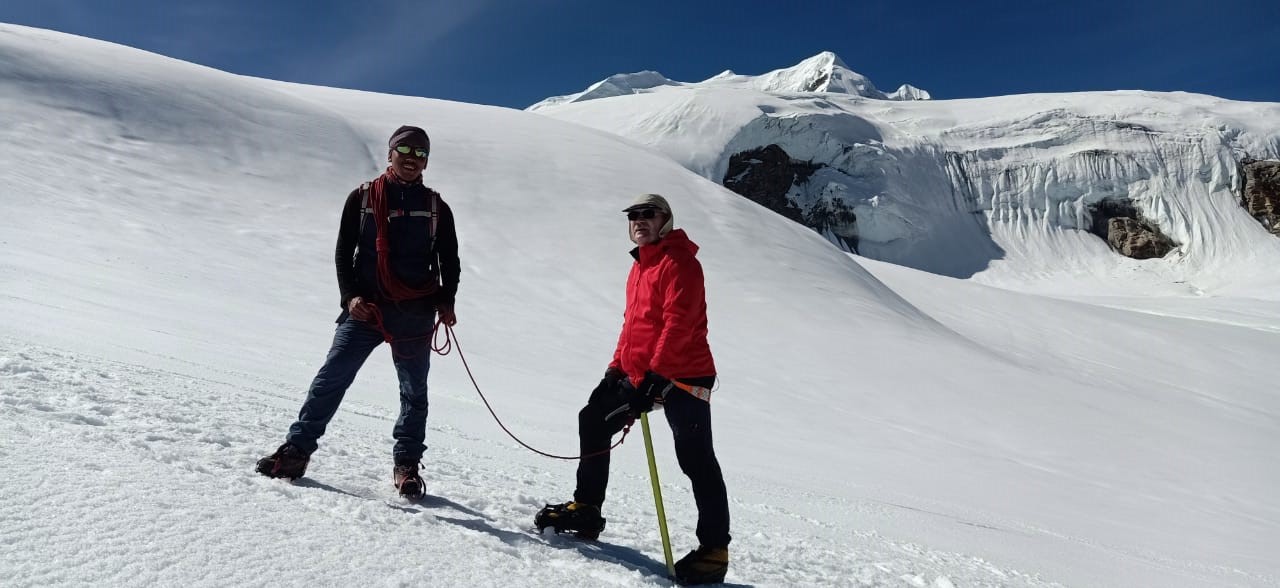
Mera Peak Climbing 20 Days
This is a chance to go climbing without the necessary permits that most climbing expeditions require in Nepal. Mera Peak fits the bill perfectly and at (6,476m/21,190ft) you will have spectacular view...
Highlights of Mera Peak Climbing In November
Climbing Mera Peak in November presents a host of highlights that contribute to a memorable Himalayan adventure:
- Scenic Flight to Lukla: The journey begins with a thrilling flight from Kathmandu to Lukla, offering aerial views of the Himalayas and an exhilarating start to the trek.
- Trek through Sherpa Villages: Passing through picturesque Sherpa villages like Namche Bazaar and Pangboche provides opportunities to experience local culture, visit monasteries, and interact with hospitable Sherpa communities.
- Natural Beauty: November showcases Nepal's post-monsoon landscapes with lush forests, blooming rhododendrons, and pristine alpine scenery along the trekking route.
- Summit Views: Climbers enjoy panoramic views of Everest, Lhotse, Makalu, and other Himalayan peaks from the summit of Mera Peak, offering a sense of achievement and awe-inspiring vistas.
- Cultural Immersion: Engaging with Sherpa culture, traditions, and hospitality enriches the trekking experience, providing insights into local lifestyles and customs.
November's quieter trails and favorable weather conditions enhance the overall trekking experience, making it a preferred time for climbers seeking a challenging yet rewarding ascent of Mera Peak.
Difficulties of Mera Peak Climbing in November
While November offers favorable conditions for climbing Mera Peak, certain challenges and difficulties should be considered:
- Cold Temperatures: Nights at higher elevations can be cold, requiring proper cold-weather gear including insulated clothing, sleeping bags, and sleeping mats to stay warm and comfortable.
- Altitude Considerations: Ascent to high altitudes requires careful acclimatization to prevent altitude sickness. Climbers should ascend gradually and include rest days at higher camps to allow the body to adjust to reduced oxygen levels.
- Weather Variability: Despite stable conditions, weather patterns in the Himalayas can change rapidly. Climbers should be prepared for potential snowfall, wind, and temperature fluctuations, especially towards the summit push.
- Physical Demands: Mera Peak climbing demands good physical fitness and stamina due to long trekking days, steep ascents, and navigating challenging terrain such as glaciers and moraines.
- Logistical Challenges: Ensuring adequate supplies of food, water, and equipment in remote areas can pose logistical challenges. It's essential to plan and pack efficiently for the trek, considering weight restrictions and porters' capacities.
Despite these challenges, proper preparation, including physical conditioning, gear readiness, and guidance from experienced guides, ensures a safe and rewarding climb of Mera Peak in November. The journey rewards climbers with stunning views, cultural immersion, and a sense of accomplishment upon reaching the summit of Nepal's highest trekking peak.

MERA PEAK EXPEDITION 14 DAYS
The Mera Peak Expedition is a 14-day trek that offers a unique and challenging route to the summit of Mera Peak. The Upper Route is a less-traveled path that takes you through some of the most remote...
Is Mera Peak Climbing In November Feasible For Me?
Climbing Mera Peak in November is feasible for climbers with adequate physical fitness, proper preparation, and a sense of adventure. While Mera Peak is considered a non-technical trekking peak, reaching an altitude of 6,476 meters (21,247 feet) requires endurance and stamina. November offers stable weather conditions with clear skies and moderate temperatures during the day, making it an ideal time for trekking and climbing in the Everest region.
To determine if Mera Peak climbing is feasible for you, assess your fitness level and previous trekking experience at high altitudes. Physical preparation should include cardiovascular exercises, strength training, and hiking with a backpack to simulate trekking conditions. Familiarize yourself with basic mountaineering skills such as using crampons, ice axes, and rope handling, although technical expertise is generally not required for Mera Peak's standard route.
Consult with experienced guides or trekking agencies to plan your itinerary, ensure proper acclimatization, and arrange logistics including permits, accommodations, and meals. With adequate preparation and guidance, Mera Peak climbing in November can be a challenging yet achievable goal for adventurous trekkers seeking a Himalayan summit experience.
Preparations For The Mera Peak Climb
Preparing for the Mera Peak climb requires thorough planning and physical conditioning to ensure a safe and enjoyable expedition:
- Physical Fitness: Engage in regular cardiovascular exercises such as hiking, running, or cycling to build stamina and endurance. Incorporate strength training to strengthen leg muscles and core stability essential for carrying a backpack and navigating uneven terrain.
- Altitude Acclimatization: Understand the risks of altitude sickness and plan a gradual ascent schedule with rest days at higher elevations to acclimatize. Follow recommended guidelines for altitude gain and monitor your health closely during the trek.
- Gear Preparation: Pack essential gear including clothing suitable for cold weather, sturdy trekking boots, a sleeping bag rated for sub-zero temperatures, and personal items like sunscreen, sunglasses, and a first aid kit. Consult with guides or trekking agencies for specific gear requirements and recommendations.
- Logistical Arrangements: Obtain necessary permits for the trek and climbing expedition. Arrange accommodations and meals through a reputable trekking agency or lodge to ensure comfort and support throughout the journey.
- Training and Familiarization: Familiarize yourself with basic mountaineering skills such as using crampons and ice axes. Practice rope handling techniques and understand safety protocols for glacier travel and high-altitude conditions.
By investing time and effort into thorough preparations, climbers can enhance their chances of success and safety during the Mera Peak climb, maximizing enjoyment of the stunning Himalayan landscapes and cultural experiences along the way.
Do I Need Any Mountaineering Skills For Mera Peak Climbing In November?
Mera Peak climbing in November does not typically require advanced mountaineering skills, as the standard route is considered non-technical. However, basic mountaineering skills and familiarity with using essential equipment are beneficial for safety and confidence during the ascent.
Key mountaineering skills useful for Mera Peak climbing include:
- Use of Crampons and Ice Axes: Climbers may encounter snow and ice slopes, particularly near the summit. Knowing how to fit and use crampons securely on boots, and how to self-arrest with an ice axe in case of a slip, enhances safety and stability on icy terrain.
- Rope Handling: While the standard route of Mera Peak does not always require roped climbing, familiarity with basic rope handling techniques is advantageous for navigating glacier crossings and steep sections.
- Glacier Travel Awareness: Understanding glacier hazards such as crevasses and seracs, and knowing how to navigate safely across glaciers, is crucial for high-altitude trekking and climbing.
- Safety and Emergency Procedures: Awareness of mountain safety protocols, including recognizing and responding to altitude sickness symptoms, understanding weather patterns, and practicing Leave No Trace principles, promotes responsible mountaineering.
While technical expertise is generally not mandatory for Mera Peak climbing in November, climbers should be prepared mentally and physically for the challenges of high-altitude trekking and be willing to learn and adapt to mountain conditions.

MERA PEAK EXPEDITION 13 DAYS
Mera Peak is one of the most popular and highest trekking peaks in Nepal, standing at 6,476 meters. The Mera Peak expedition is a 13-day trek that takes you through some of the most breathtaking scene...
What About Accommodations And Meals While Mera Peak Climbing In November?
Accommodations and meals while climbing Mera Peak in November are typically arranged through trekking agencies or lodges along the trekking route. The Khumbu region, including villages like Lukla, Namche Bazaar, and Khare, offers a range of accommodations from basic tea houses to more comfortable lodges with amenities such as hot showers and electricity (where available).
During the trek, climbers stay in tea houses or lodges at various points along the route, providing essential facilities such as meals, accommodation, and social areas for relaxation. Meals typically include a variety of Nepali and Western dishes, providing energy and nutrition for trekkers.
In November, accommodation availability may be more plentiful compared to peak trekking seasons like spring, reducing the need for advance bookings. However, it's advisable to confirm accommodations through a trekking agency to ensure availability, especially at higher camps closer to Mera Peak Base Camp and High Camp.
While facilities may vary in comfort and amenities, accommodations and meals in the Khumbu region cater to trekkers and climbers, offering a welcoming environment to rest and refuel before continuing the ascent towards Mera Peak.
Useful Tips For Mera Peak Climbing In November
Climbing Mera Peak in November presents unique challenges and rewards. Here are some useful tips to enhance your experience:
- Prepare for Cold Weather: November temperatures can drop significantly at higher altitudes. Pack warm, layered clothing including thermal base layers, insulated jackets, gloves, and hats to stay comfortable.
- Stay Hydrated: Despite cooler temperatures, dehydration can still occur at high altitudes. Drink plenty of fluids throughout the trek, including water and electrolyte solutions.
- Pack Essential Gear: Ensure you have necessary climbing gear such as crampons, ice axes, harnesses, and ropes. Check equipment functionality before departure and replace any worn-out gear.
- Acclimatize Properly: Plan your ascent with sufficient rest days for acclimatization. Follow gradual altitude gain guidelines and listen to your body's signals to prevent altitude sickness.
- Choose Reputable Guides: Opt for experienced guides or trekking agencies familiar with the Mera Peak route and conditions. They provide safety, navigation support, and local insights.
- Monitor Weather Conditions: Stay informed about weather forecasts and be prepared for changes. November generally offers clear skies, but occasional snowfall or wind can occur.
- Respect Local Culture: Embrace Sherpa hospitality and respect local customs. Learn basic Nepali phrases and engage with local communities along the trek.
By following these tips, you can maximize safety, enjoyment, and success during your Mera Peak climbing expedition in November.
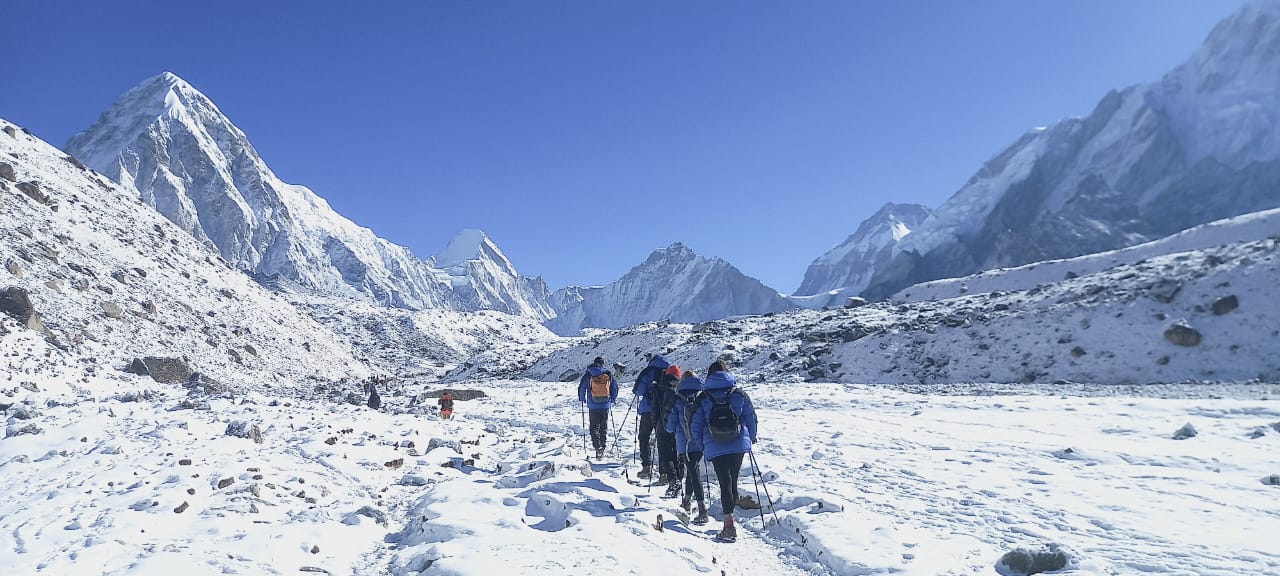
MERA AND ISLAND PEAK CLIMBING
Embark on a thrilling mountaineering adventure like no other with the Mera and Island Peak Climbing expedition crafted by We Sherpa Expedition and Trekking. This exclusive package is designed for adve...
Can I See Mount Everest From Mera Peak?
Yes, climbers are rewarded with stunning panoramic views from Mera Peak, including prominent Himalayan giants like Mount Everest (Sagarmatha). Situated in the Solu Khumbu region of Nepal, Mera Peak offers one of the best vantage points to admire Everest's majestic peak along with neighboring peaks such as Lhotse, Makalu, and Cho Oyu.
From Mera Peak's summit, climbers experience a breathtaking 360-degree panorama of snow-capped peaks, deep valleys, and pristine glaciers. The clear November skies enhance visibility, allowing for memorable sunrise and sunset views over the Himalayas.
Seeing Mount Everest from Mera Peak is a highlight of the expedition, rewarding climbers with a sense of achievement and awe-inspiring natural beauty. It serves as a testament to the physical and mental preparation required for high-altitude climbing in Nepal's Himalayas.
Which Mountain Should I Climb After Mera Peak?
After conquering Mera Peak, climbers often seek new challenges in the Nepalese Himalayas. Popular peaks for climbers looking to expand their mountaineering experiences include:
- Island Peak (Imja Tse): Known for its stunning views of Lhotse and Ama Dablam, Island Peak offers a more technical climb requiring basic mountaineering skills.
- Lobuche Peak: Located near Everest Base Camp, Lobuche East and Lobuche West provide opportunities for climbers to enjoy Everest views and technical climbing challenges.
- Ama Dablam: Known as one of the most beautiful peaks in the world, Ama Dablam requires advanced mountaineering skills and offers a demanding yet rewarding ascent.
- Pisang Peak: In the Annapurna region, Pisang Peak combines trekking through the Annapurna Circuit with a moderate technical climb, ideal for climbers seeking diverse landscapes.
- Cho Oyu: For experienced climbers seeking an eight-thousander, Cho Oyu offers a less technical ascent compared to other peaks in the region.
Choosing the next mountain after Mera Peak depends on your climbing experience, fitness level, and objectives. Consult with experienced guides or trekking agencies to select a peak that aligns with your interests and abilities.

ISLAND PEAK CLIMBING
Sherpa Expedition & Trekking (Est.1977) are pleased to announce FOR ADVENTURERS the most awesome, exhilarating & unforgettable climbing and treks on offer anywhere today!...
Can I Hire Climbing Gear From Khare?
Yes, Khare, a small settlement en route to Mera Peak Base Camp, offers opportunities to rent climbing gear and equipment. Local lodges and trekking agencies in Khare provide essential mountaineering equipment such as crampons, ice axes, harnesses, ropes, and helmets for climbers. Renting gear from Khare can be convenient for trekkers who prefer not to carry bulky equipment from Kathmandu or who need to replace damaged or lost gear during the expedition.
Before renting climbing gear in Khare, ensure that equipment is in good condition and meets safety standards. Verify rental terms, costs, and availability with local providers or your trekking agency to plan accordingly. Packing essentials like clothing, boots, and personal gear is recommended, while renting specialized climbing equipment locally can streamline your Mera Peak climbing experience.
Conclusion
Climbing Mera Peak in November offers a thrilling adventure amidst Nepal's majestic Himalayas, combining stunning vistas, cultural experiences, and personal achievement. Preparation is key, from physical conditioning and gear readiness to choosing experienced guides and respecting local customs.
November's stable weather conditions and clear skies provide optimal trekking and climbing conditions, allowing climbers to enjoy panoramic views including Mount Everest. Whether you're planning your first Himalayan ascent or seeking new challenges after Mera Peak, Nepal's peaks offer diverse opportunities for mountaineers of all levels.
Embrace the journey, immerse yourself in the natural beauty of the Khumbu region, and celebrate reaching the summit of Mera Peak with a sense of accomplishment and wonder.
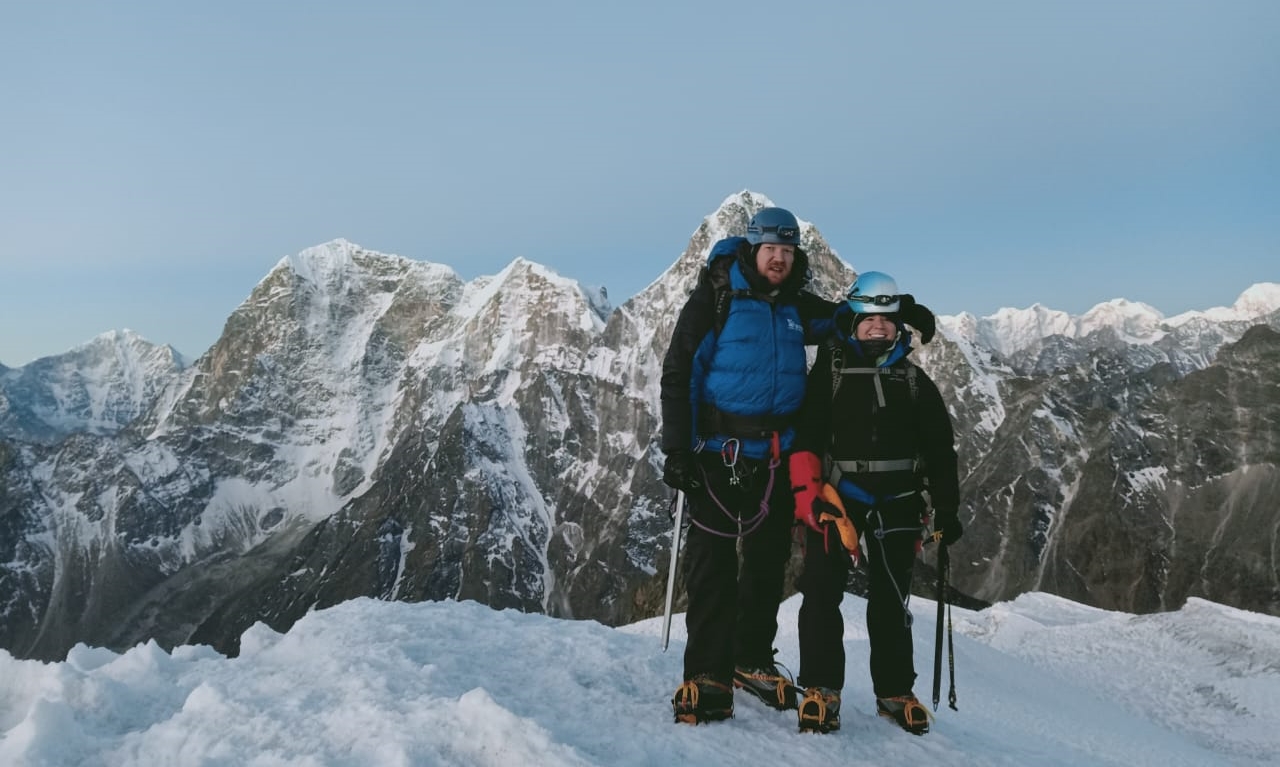
LOBUCHE PEAK CLIMBING
Lobuche East (6,119m/20,075ft), set in Nepal's stunning Khumbu on the Nepalese side of Everest.The best time to go trekking in Nepal is in Autumn (September-November) and in...
Mera Peak Climbing Packages
Mera Peak Summit Return By Helicopter

ISLAND PEAK SUMMIT RETURN BY HELICOPTER
Many of us only dream of standing on a tall peak looking down on the world. This is a great climb that will satisfy this desire. Island Peak, also referred to as Imja Tse, is a 6187-meter high peak in...
Any Questions? Let Us Know.
Recent Posts
17th June, 2025


















